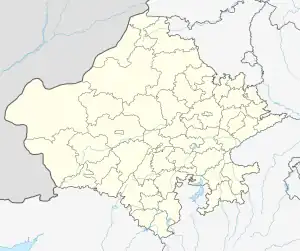Tonk, India
Tonk is a district in the Indian state of Rajasthan. The town of Tonk is situated 95 km (60 mi) by road south from Jaipur, near the right bank of the Banas River. It is the administrative headquarters of Tonk District. Tonk was also the capital of the eponymous princely state of British India from 1817 to 1947. Kamal Amrohi's movie Razia Sultan were shot in Tonk in 1981–82. Famous places in Tonk include: Shahi Jama Masjid, Bisalpur Dam, Arabic Persian Research Institute, Sunhari Kothi, Hathi Bhata, Annapurna Dungri Ganesh Temple, Rasiya Ki Tekri, Kidwai Park, Ghantaghar, Kamdhenu Circle, Nehru Garden, Chaturbhuj Talab Lake. It is also known as Rajasthan's Nawabo ka shahar.[1]
Tonk | |
|---|---|
City | |
| Nickname: Nawabi Nagari | |
 Tonk  Tonk | |
| Coordinates: 26.17°N 75.78°E | |
| Country | |
| State | Rajasthan |
| District | Tonk |
| Government | |
| • Body | Nagar Parishad |
| Elevation | 289 m (948 ft) |
| Population (2011) | |
| • Total | 165,294 |
| Languages | |
| • Official | Hindi |
| Time zone | UTC+5:30 (IST) |
| ISO 3166 code | RJ-IN |
| Vehicle registration | RJ-26 |
| Website | www |
Demographics
In the 2011 Indian census,[2] Tonk had a population of 165,294, with 48% being female. 14% of the population is age six and under. Tonk has an average literacy rate of 68.62%: 77.68% in males, and 59.18% in females. In terms of religion, 48% were Muslim, 50% were Hindu, 1.8% were Jain and 0.2% others.
Muhammad Amir Khan (1769–1834), a leader of Pashtun descent from Afghanistan. In 1806, Khan conquered the area, taking it from a retreating regime Yashwant Rao Holkar. The British government captured it in turn. Khan then received the state of Tonk from the British Government who returned it.[3] In 1817, after the Third Anglo-Maratha War, Amir Khan submitted to the British British East India Company and kept his territory of Tonk while receiving the title of Nawab.[4] Tonk was founded one year later after Khan was granted land by the ruler of Indore.
A municipality was established at Tonk in 1885.[5]
See also
References
- "पोर्टल, राजस्थान सरकार". tonk.rajasthan.gov.in. Retrieved 30 December 2022.
- "Census of India 2011: Data from the 2011 Census, including cities, villages and towns (Provisional)". Census Commission of India. Retrieved 1 January 2021.
- Lethbridge, Sir Roper (2005). The Golden Book of India: A Genealogical and Biographical Dictionary of the Ruling Princes, Chiefs, Nobles, and Other Personages, Titled or Decorated of the Indian Empire. ISBN 9788187879541.
- Princely States of India
- Rima Hooja (2006). A History of Rajasthan. Rupa. p. 1166. ISBN 9788129108906.